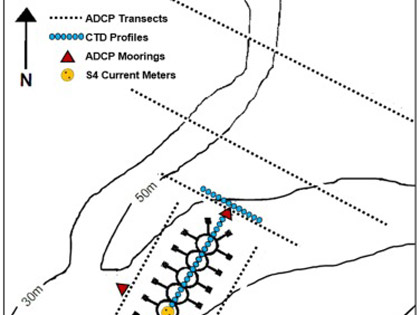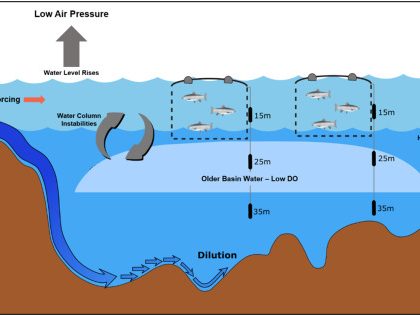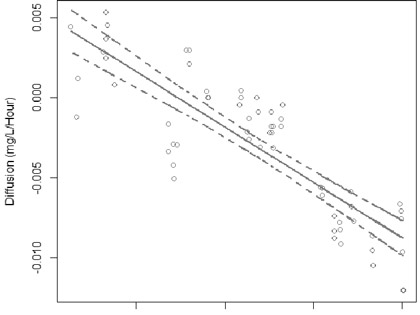RESEARCH
RECENT PUBLICATIONS
Coastal upwelling along the west coast of Sabah and its impact on coastal aquaculture management
Wong SzuYie, Neil David Hartstein, Johnathan Daniel Maxey, Mohd ShukryBin Bakar, Loo Chew Hui
Ocean & Coastal Management, Volume 211, October 2021, 105781
Abstract
The aquaculture industry in Malaysia is currently growing at nearly 9 percent per year and is generating more than 250,000 tons of production per annum. However, little commercial scale aquaculture is present along the west coast of the state of Sabah. Few if any studies have been conducted to investigate aquaculture site suitability along the west coast of Sabah and the wider west coast of Borneo from an environmental or coastal management perspective. To determine the site suitability for marine aquaculture and other coastal resource users there needs to be an improved understanding of the physical, chemical, and biological characteristics of the coastal environment. One year of data collection including the long-term deployment of Conductivity, Temperature and Depth (CTD) sensors, and bi-monthly water column and seabed sediment sampling was undertaken to provide an indication if the coastal waters between Kota Belud and Kudat are suitable for marine aquaculture purposes. The site provided an analogy for much of the west coast of Borneo, especially the west coast of Sabah, due to similar oceanographic drivers in the region. Results indicated that during the NE monsoon period there is dramatic decrease in water temperature due to the upwelling of cold dense nutrient rich water onto the west coast of Sabah’s continental shelf from deeper offshore areas of the South China Sea. This large change in temperature will likely rule out the potential commercial marine grow out of such species as Asian Seabass and perhaps Tropical Spiny Lobsters. Other species such as Cobia, Grouper and Snapper which have a wider tolerance for temperature change will likely be suitable but at times will be stressed due to magnitude of the observed changes. Such observations have ramifications in regard to site suitability for future resource consent applications for open ocean and coastal aquaculture along the west coast of Borneo. In summary the study highlights how physical processes can impact on resource use and development in a coastal setting.
Hydrodynamic implications in and around a caged finfish farm and its implications on the dispersal of farm debris
Neil D. Hartstein, Brad de Young, M. Robin Anderson, Johnathan Daniel Maxey
Aquaculture Engineering, Volume 93, May 2021, 102154
Abstract
One of the key factors in determining the accumulation of sediment and soluble nutrients within a lease is water movement. Water masses entering and leaving the farm determine the finfish ecosystem interaction. Understanding the hydrodynamic interaction with the farm is therefore key to understanding the potential ecological effects of individual farms. In addition, finfish farms are now being proposed in exposed offshore environments and have caused concern regarding their potential down stream impacts on currents and wave climate. Seven current meters, oxygen probes and CTD were deployed to examine the hydrodynamic interactions inside and outside a 270 m long Salmon farm in Newfoundland, Canada. Current meter results indicate that the finfish farm cages have a clear shadowing effect on the currents. Currents upstream were found to be considerably faster than those recorded downstream during the sampling period. Current speeds inside the farm were also found to be considerably slower than those found outside of the farm especially during high flow events. In situ observations of currents were found to be similar to those predicted by previous CFD and hydrodynamic modelling studies. Modeling was also undertaken to calculate the energy lost as currents enter and leave a series of fish cages. In comparison to the observed flow the model compares relatively well. Flow recorded downstream of the farm was observed to be in the range predicted by the model as was the flow recorded inside and outside the cages. Current speed downstream of the farm is clearly affected by farm orientation which has important implications for the dispersal of farm debris. Average oxygen saturation within the cages over the 5 day sampling period was 80.2 %± SD 5.7 %, compared to nearly 100 %, 20 m and 50 m from the farm site. Orientation of the farm may play some part in determining the location and amount of oxygen depletion within the farm. The farm also acts to push water from deeper in the water column up into the cages which has implications for farms situated in heavily stratified environments.
Dissolved oxygen consumption in a fjord-like estuary, Macquarie Harbour, Tasmania
Johnathan D. Maxey, Neil D. Hartstein, Amy Yee Hui Then, Matt Barrenger
Estuarine, Coastal and Shelf Science Volume 246, 5 November 2020, 107016
Abstract
Microbial respiration of organic matter (OM) is a key driver of deoxygenation and hypoxia. In fjord-like estuaries with established aquaculture industries understanding drivers of oxygen demand, and the relative importance of different drivers, is crucial for improving fish farming management in those systems. We designed a study to examine patterns of pelagic oxygen demand (POD) in a fjord-like estuary on the west coast of Tasmania, Macquarie Harbour, and relate those observations to physical forcings and major OM sources. Monthly water column sampling and bottle incubation experiments were conducted from June to November 2017. Water was collected throughout the harbour including river and oceanic endmembers as well as transects leading away from fish farms. Water was incubated from 4 different depths spanning the surface water to the seabed. Regression modelling was used to examine the relationship between POD, riverine OM loading, proximity to fish farms and the major system endmembers, depth, harbour region, concentration of dissolved oxygen, and month. POD reached rates as high as 0.108 mg L-1 hour-1 with the greatest POD observed above the halocline and during high river flow/OM loading months. Regression modelling showed that important drivers of POD are spatially specific along vertical and longitudinal gradients. The importance of riverine OM loading waned with depth primarily due to mixing dynamics of dissolved organic carbon across the halocline. Proximity to fish farms was an important but localized explanatory variable for POD in the halocline and basin waters, but not a significant driver of POD compared to the Gordon River. Based on the POD rates observed in this study, hypoxia can be established in less than 9 days in the basin waters and is primarily driven by pelagic oxygen sinks (95%–98%), not sediment sinks. It is crucial that aquaculture management accounts for natural, and/or preexisting, variation in endmember OM loading and its effect on DO dynamics, in these systems.
Drivers of deep water renewal in Macquarie Harbour, Tasmania
Neil D. Hartstein, Johnathan D. Maxey, Justyn Chew Hui Loo, Amy Yee-Hui Then
Journal of Marine Systems, Volume 199, November 2019, 103226
Abstract
Macquarie Harbour is a fjord-like estuary located on the west coast of Tasmania and is home to a growing aquaculture industry. The harbour is oriented with the mouth on its north west end and two main tributaries located on its northeast and southeast ends. Both of the system’s major tributaries have hydroelectric power schemes controlling catchment discharge into the harbour. The harbour has a history of low oxygen concentrations and the bottom water is often oxygen poor. No study to date has described the underlying mechanisms of deep water renewal and oxygenation in the system.
Approximately 5 years of data from monthly dissolved oxygen, salinity, and temperature profiles, located throughout the harbour, and 3 continuous logger stations was analysed with water level and meteorological data. These data were used to describe the drivers of water level and deep water oxygen renewal in the system. This study provides a first order estimate of the net mass of dissolved oxygen entering via these marine water intrusion events.
Data analysis indicates that deep water renewal appears to occur episodically, with only 2 significant events recorded over a 5 year period, though a number of smaller events were also recorded on a monthly basis. The largest events were observed during winter and late autumn and are associated with strong north westerly winds and a sudden drop in atmospheric pressure. The drop in pressure results in an increase in water level that allows marine water to enter the harbour via the mouth. The north westerly winds act to push surface water to the southern end of the harbour allowing more water to flood over the sill into the Sophia basin.
Analysis of oxygen, temperature and salinity logger data indicates that larger renewal events create water column instabilities which can provide a potential threat to the salmon aquaculture industry situated in the harbour. The frequency of renewals also has implications on the standing oxygen concentrations in the harbour, with fewer events likely resulting in greater periods of hypoxia in the bottom and mid water column.
Simple quality control technique to identify dissolved oxygen diffusion issues with biochemical oxygen demand bottle incubations
Johnathan Daniel Maxey, Neil David Hartstein, Dorathy Penjinus and Alan Kerroux
Borneo Journal of Marine Science and Aquaculture Vol. 1/2017
Abstract
Stratified estuaries are home to expanding aquaculture activities whose ecological footprints can be observed through trends in microbial community respiration in the water column. Bottle incubations are widely used to measure water column community respiration in marine and freshwater ecosystems by measuring the flux of dissolved oxygen occurring in the bottle over a period of time. When in situ dissolved oxygen (DO) concentrations are markedly different than DO concentration of the incubation medium the potential for diffusion of oxygen across the bottle opening is great and may be especially pronounced in strongly stratified systems with relatively low rates of pelagic oxygen consumption. We incubated 60 Biochemical Oxygen Demand (BOD) bottles filled with sterilized water with DO concentrations ranging from 2.51 mg O2 L-1 to 10.03 mg O2 L-1 for 24 hours in a temperature controlled water bath. There was a significant relationship when DO flux was set as a function of initial DO (DO Flux = -0.0017x + 0.0085, r2 = 0.72, p < 2.2 e-16). DO fluxes ranged from -0.012 mg O2 L-1 hour-1 to 0.005 mg O2 L-1 hour-1 for bottles incubated with initial DO ranging from 10.03 mg O2 L-1 to 3.31 mg O2 L-1, respectively. These results suggest that diffusion across the ground glass seal of BOD bottles is possible and that extra precaution through parallel diffusion controls should be considered when measuring pelagic respiration using BOD bottle incubations in systems with relatively low or relatively high in situ DO concentrations.
IN REVIEW
- Marine Finfish aquaculture Planning in Data Poor regions:using MCDM and numerical modelling tools to aide industry expansion along the North Borneo West Coast.
- The influence of mesoscale climate drivers on hypoxia in a fjord-like deep coastal inlet and its potential implications regarding climate change and greenhouse gas production: examining a decade of water quality data.
CURRENT RESEARCH
- Marine Area Spatial Planning
- Greenhouse gas emissions from sediments
- Boulder beach formation and geo-morphology
- Fin-fish cage and hydrodynamic implications
- Waste capture within the aquaculture industry




